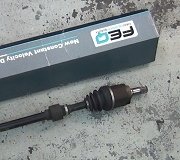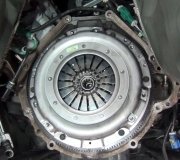The 3.3L and 3.5L are two totally different engines. You would have to replace the Engine Computer, engine wiring harness, and some of the things that bolt to the engine including the exhaust system. Switching to a different engine year involves a real lot of work. Switching to a different size engine involves even more work, and it will never perform correctly.
1996 was the first year for OBD2, (on-board diagnostics, version 2). Among many other things, that includes adding two oxygen sensors after the catalytic converters, and a fuel supply leak detection pump and system. All of that is incorporated into the Engine Computer.
Whoever told you a "whole new front end" is needed is giving you a lazy answer. That's like getting a dent in the door and being told you need "a whole new body". With body damage and with steering and suspension systems you replace what's broken or worn out out. A detailed inspection should include a written list of exactly which parts need to be replaced. Feeling like tires are about to fall off can mean different things to different people and have different causes. The most common cause of a severe wobble or shimmy at low speeds is a broken tire belt. You'll see the steering wheel turn back and forth while driving slowly through a parking lot. Broken belts are pretty easy to identify when the car is jacked up and the tires are spun by hand in the back or by running the engine in gear to watch the front ones.
Other causes of a wobble include a bent wheel or bent hub from hitting something. The wheel is a lot more common than the bent hub. Sloppy ball joints and struts can let the tire shift position as you're driving. That will cause an unstable feeling but usually not a wobble or shimmy. Clunks over bumps or when turning are associated with those parts. Sloppy outer tie rod ends will cause steering wander at higher speeds and a feather edge tire wear on both front tires. Anti-sway bar links will cause a rattle over small bumps. They won't cause a handling problem and you won't hear them rattle at higher speeds. To identify them quickly, you'll hear them thumping while driving straight through a parking lot each time you hit a small bump, but the noise will stop when you have the steering wheel turned either way as little as 1/8th turn. Doing so raises one front corner of the car and lowers the other corner. That puts tension on the sloppy joints on the links and prevents them from rattling. Those links were a high-failure item. They often rattled in as little as 20,000 miles. Replacing them is rather difficult unless you have air tools. Getting the two nuts off is hard because the studs are hard to keep from spinning, but once they're off, installing the new links takes just a few minutes.
In very rare cases a sloppy front wheel bearing will let that wheel wobble back and forth but that doesn't happen suddenly. Bearing problems start with a buzzing sound that sounds like an airplane engine. If that is ignored for a real long time, the wobble can develop but I've only seen that once in over 25 years.
Warped brake rotors are another source of a wobble. You'll feel the pulsation in the brake pedal. That is common on any car and has nothing to do with the steering or suspension systems or the alignment.
You might consider looking for a community college with an Automotive program. If they are currently teaching Steering, Suspension, and Alignment, have them inspect your car or diagnose the problem. We charged $10.00 per hour and very little markup on parts. The drawback is it might take a few weeks to complete any repairs, but you'll save a lot of money and it will take less time than trying to install the wrong size engine.
Saturday, September 24th, 2011 AT 8:10 PM


